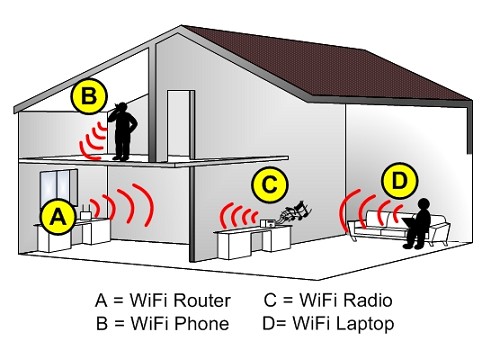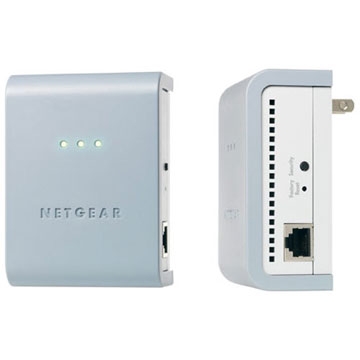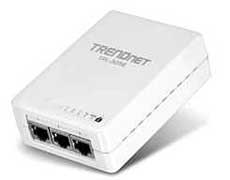Wifi versus Powerline Networking
The Problem
My personal home network may be a little more complicated than average. I used to work as a full time Unix/Linux sys-admin so I have some specific ideas about how I like to do things. But I suffer from a similar problem as many, many other people: I have more than one computer spread through my house and they aren’t all in the same room as my DSL router. To complicate things I have an upstairs and a downstairs basement and it would be impossible to run cables every where I need to go.
Wifi
The obvious solution is to connect a Wifi router to my DSL box and link up everything (a sever, a couple desktop PC’s, a couple laptops, a couple smart phones, etc.) all through the wifi. This actually works pretty ok, but I have some annoyances:
- Two desktop PC’s next to each other have to talk at Wifi speeds rather than 100Mbit ethernet speeds
- Even within my house, I suffer from signal degradation between the basement and the upstairs. Some areas don’t get a clean signal and can’t get nearly the bandwidth I should theoretically be able to get.
- I do regular backups of all my PC’s to a server so I generate a *lot* of traffic a *lot* of the time and my daily interactive network use is affected because I don’t always have a lot of spare band width over the air. I end up with web connections randomly timing out once in a while, and various things not working consistently. This is a frustration since I work out of my home office and much of my day depends on being online.
- Wifi transmits a lot of high energy RF right by your head or lap or other body parts … I suppose that’s not much of a health issue, or so I’m led to believe.
Powerline Ethernet
Say whatever you want about walmart, but I was up at my local store poking around and noticed a clearance rack in the electronics section. They were selling a couple things called “Netgear Powerline 85 Adapter Kit”. I had no idea what that was, but it caught my eye long enough to take a closer look at the box. Then I went home and did some googling. Finally the next day I rushed back to the store and strangely, all 4 units were still on the clearance rack so I bought one set. I must have been the only one to notice the geek gold mine!
What is Powerline Networking?
Powerline networking allows you to run ethernet over your existing AC wiring, rather than running dedicated ethernet lines or going over the air with wifi. This is really cool, I didn’t know you this was possible, so I had to try it out and see how it worked.
How does it work?
It works pretty well! In my case, my package came with two adapters that each plug into an AC outlet and have an RJ-45 jack on the side. Instead of connecting two devices by running a 300′ ethernet cable across the basement floor, up the stairs, through the living room, down, the hall, and into my office … I just run a very short ethernet cable (included) to a powerline adapter and plug that into the nearest AC outlet. Now I go to the other end of my house and plug a very short ethernet cable (also included) into the 2nd powerline adapter and plug that into the nearest AC outlet. The 2 powerline adapters find each other automatically and create a bridge over my AC wiring. My two devices are now happily talking and I’m not tripping over long ugly wires strung around my house.
So is it any better than Wifi?
I should qualify the following comments and suggest that for most people your mileage may vary. There are potential issues that could make powerline networking not work so well and you need to watch out for these.
- Do not plug your powerline adapater into a power strip, or a power strip plugged into to another power strip. For best results and best bandwidth, you need to plug directly into a wall outlet.
- It is possible for electric appliances and other things to create noise on your AC power lines and disrupt the ethernet networking signal. Better devices include better filtering, but this is always a potential issue.
- I don’t know how far a network could extend over AC and when you might start seeing signal degradation and slow downs.
- I don’t know how many devices you can stack up (right now I just use a single pair) and how the system would react to higher traffic loads.
- Base bandwidth improved noticeably. My connection to the server on the other side can now get more data through faster than before. This is a big win and worth the expense by itself.
- I see more consistent service under load. With wifi I noticed that if I was doing a long download, that could saturate the link and anything else I tried to do could really suffer. Powerline networking seems to do a better job and managing contention and avoiding starvation of one connection in favor of another. Everything seems better balanced, and even if I have the link saturated with a big download (or a long level 0 backup), my interactive use seems to be snappy and responsive … something that didn’t happen with wifi.
What else is cool about powerline networking?
I’m sure if you’ve read this far you can see I’m not a powerline networking expert, but here are some cool things I discovered along the way:
- I purchased 85Mbit devices, but I see that now 200Mbit devices are available.
- My devices suck up an AC outlet which can be a pain. Newer devices often have an AC pass through so you don’t lose an outlet.
- I’ve seen devices with 3 ethernet jacks rather than just one. These serve as a little mini ethernet hub for those of us that might have more than one network device in a room.
- My devices offer encryption at the OS level (i.e. they come with a windows drivers.) Mostly I run linux so I don’t think that helps me much. But because I run linux, most of my LAN connections are already encrypted via ssh or https, so I’m not too worried about that. I think newer devices offer better plug and play encryption options if that’s an important consideration.


